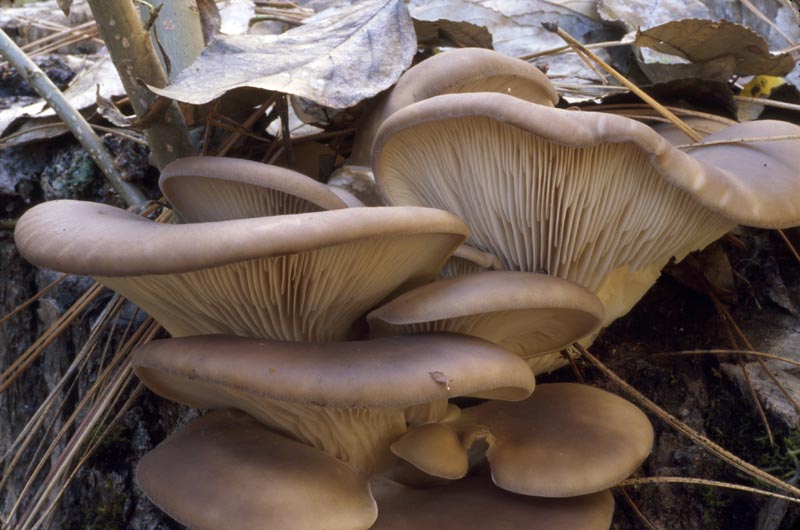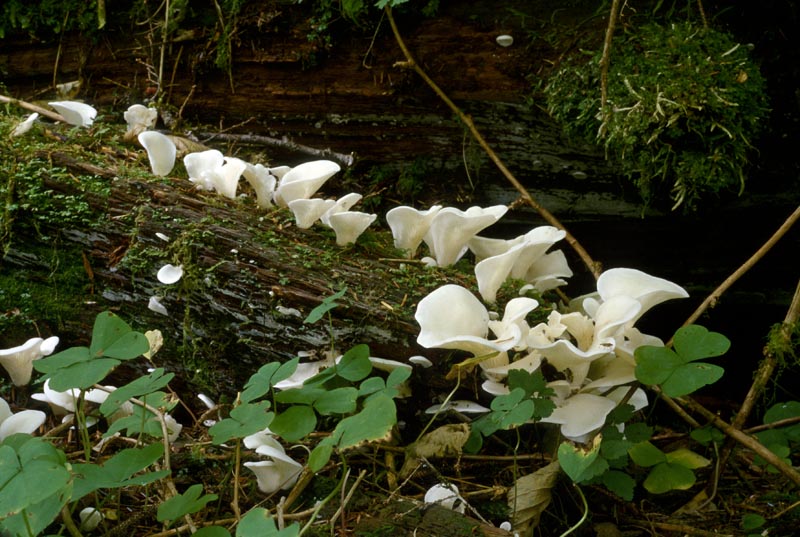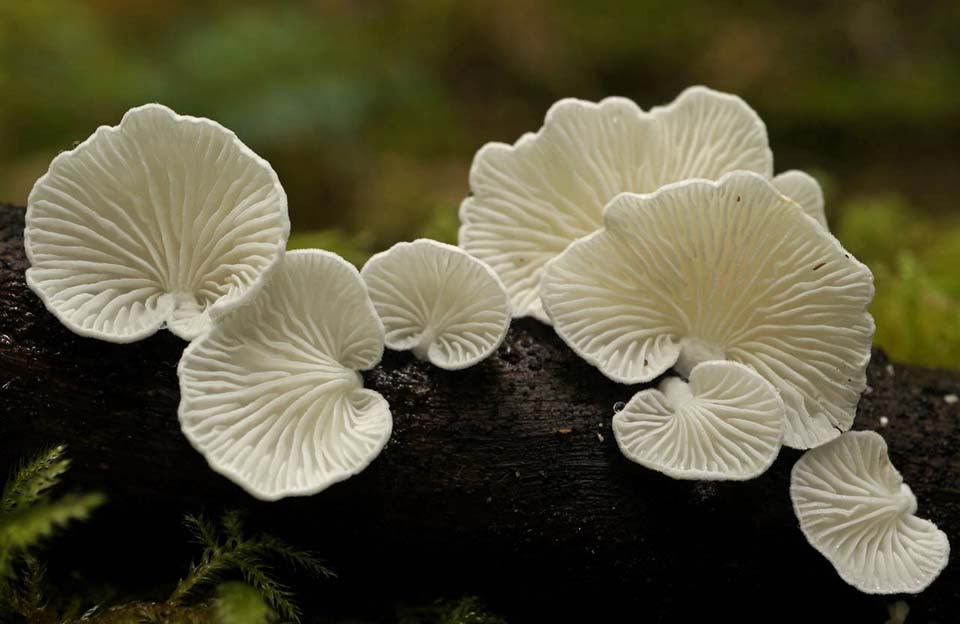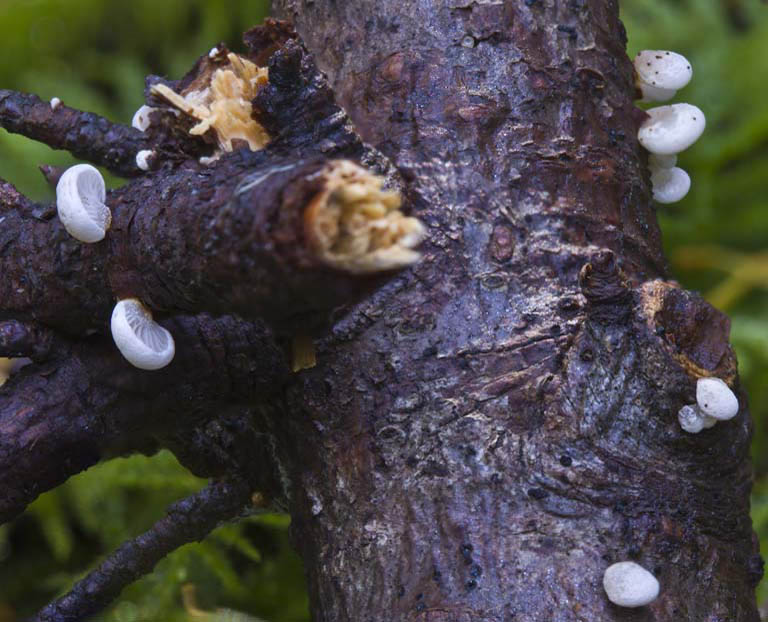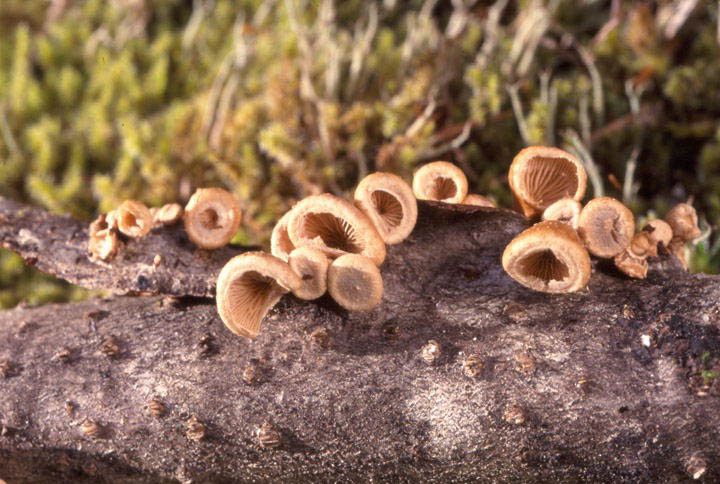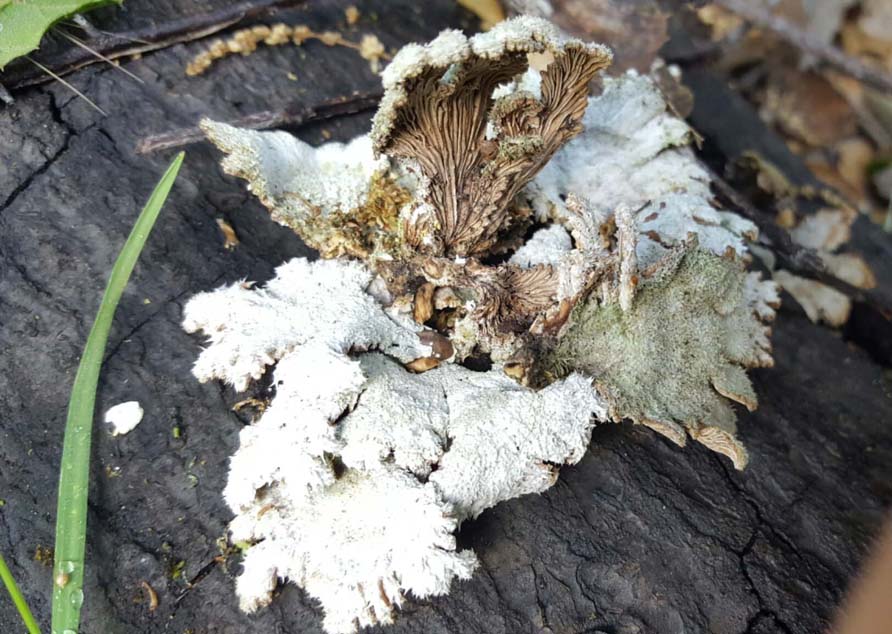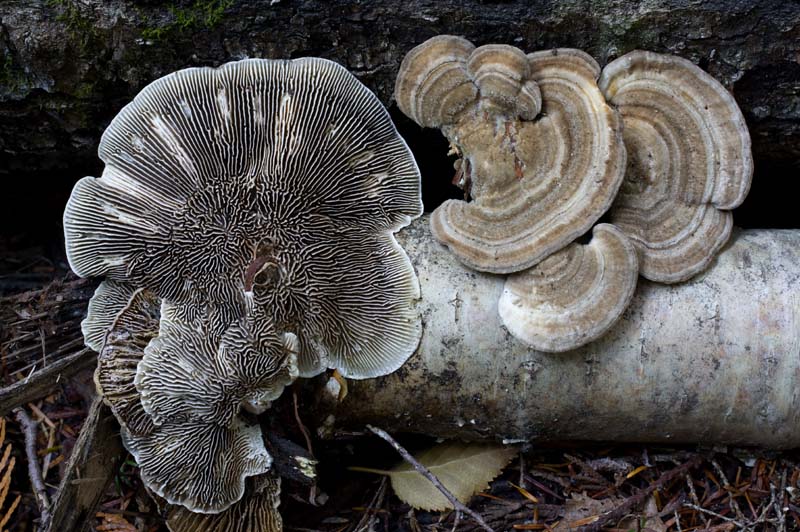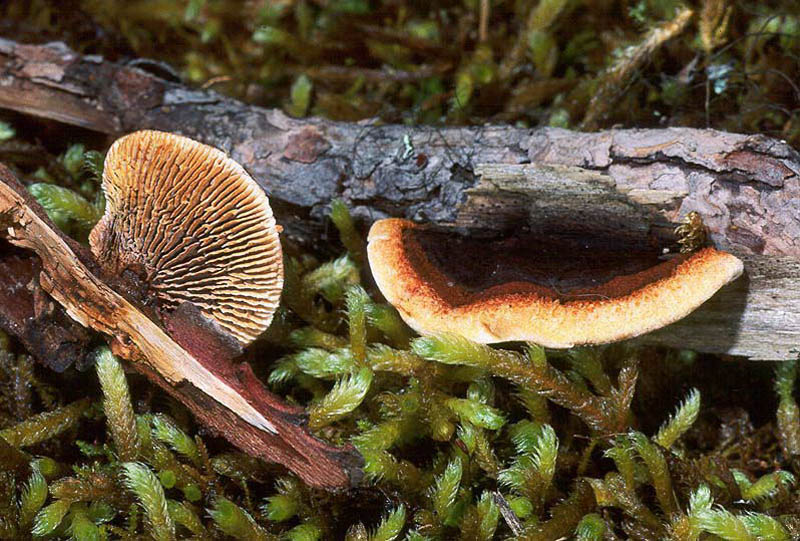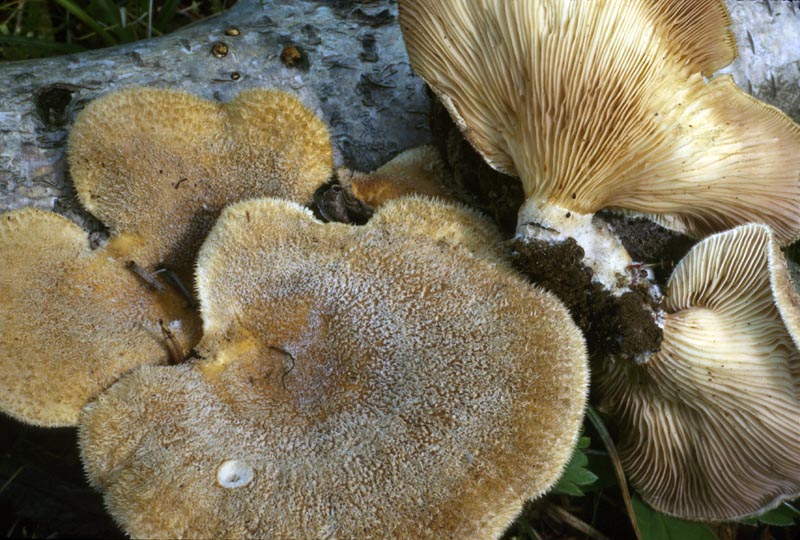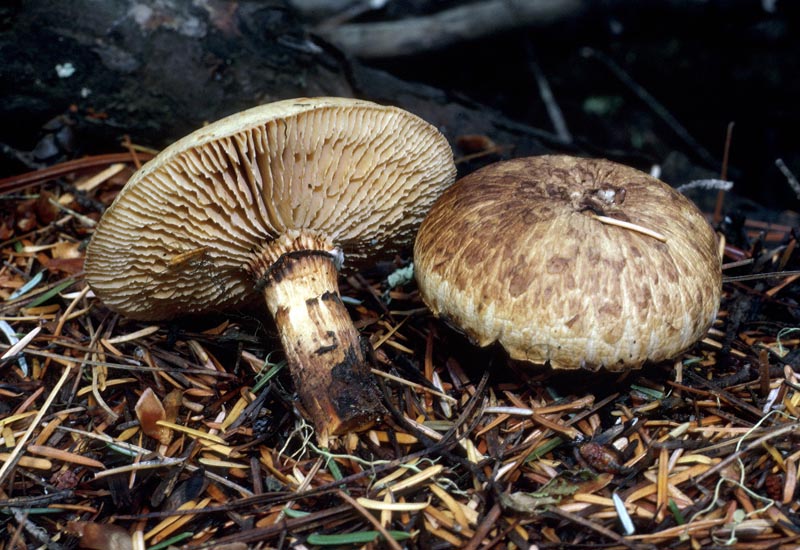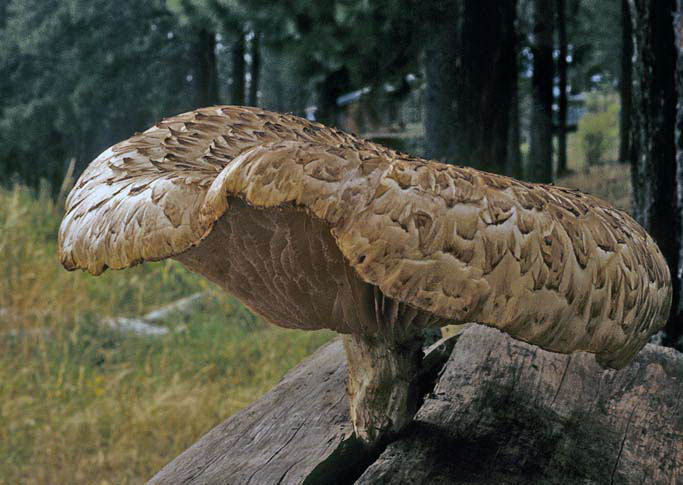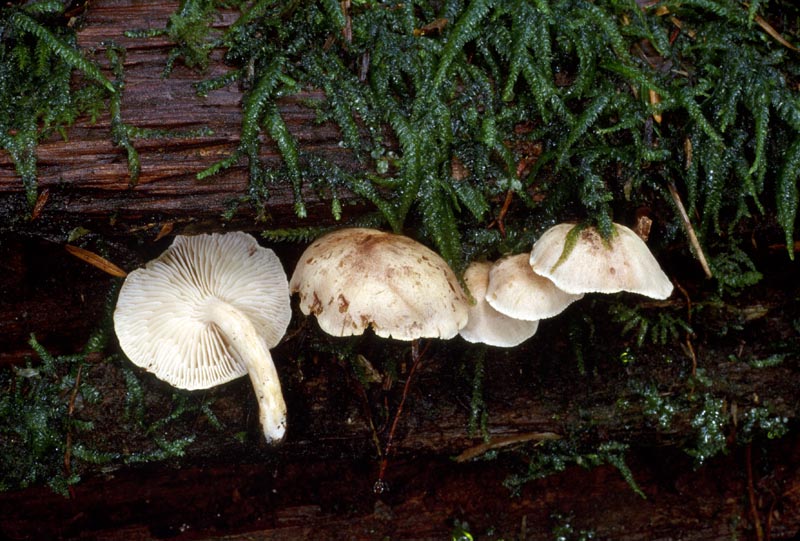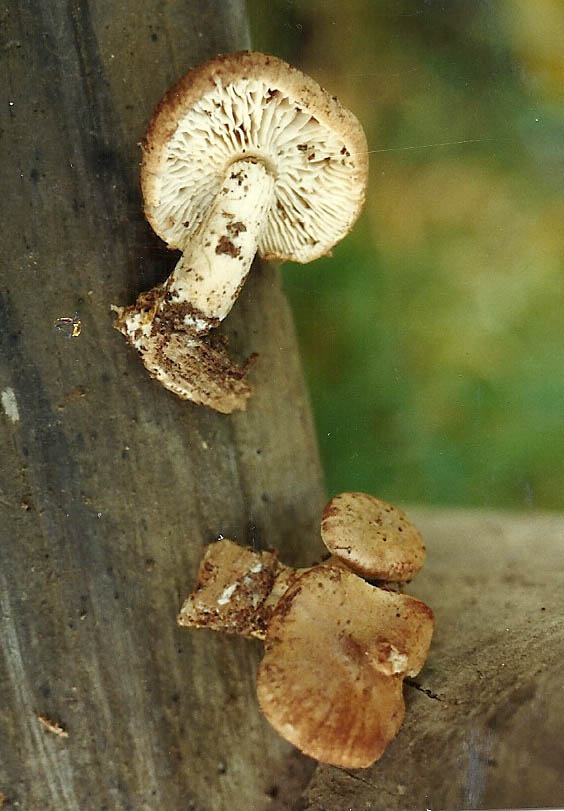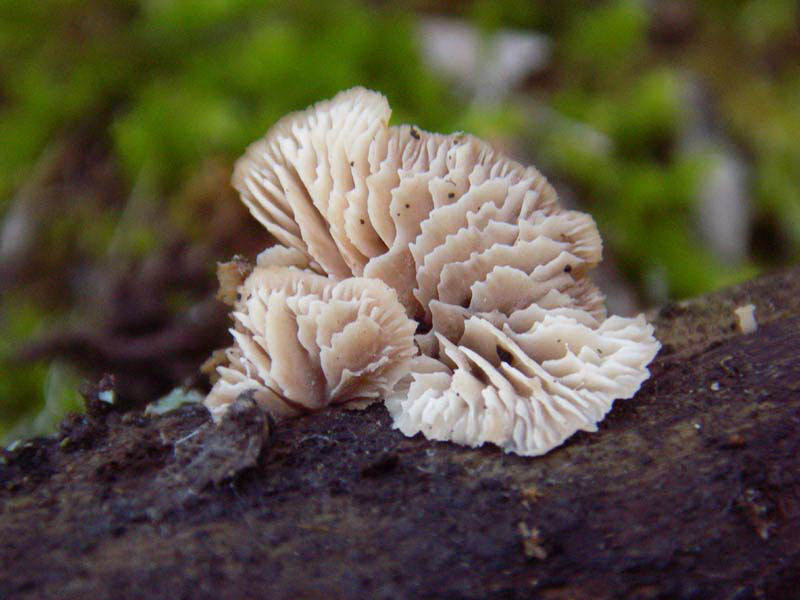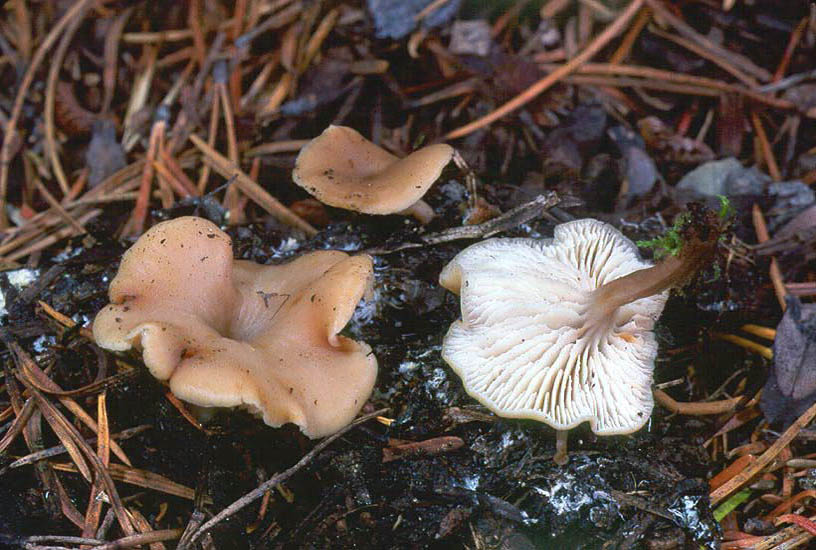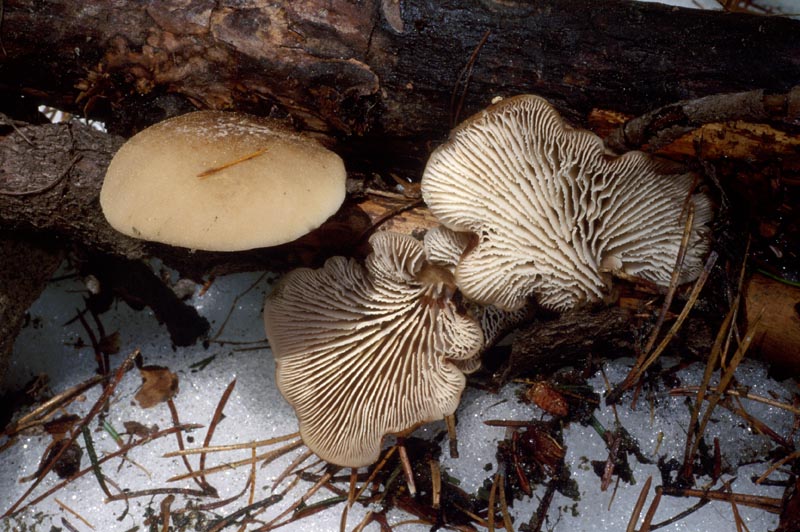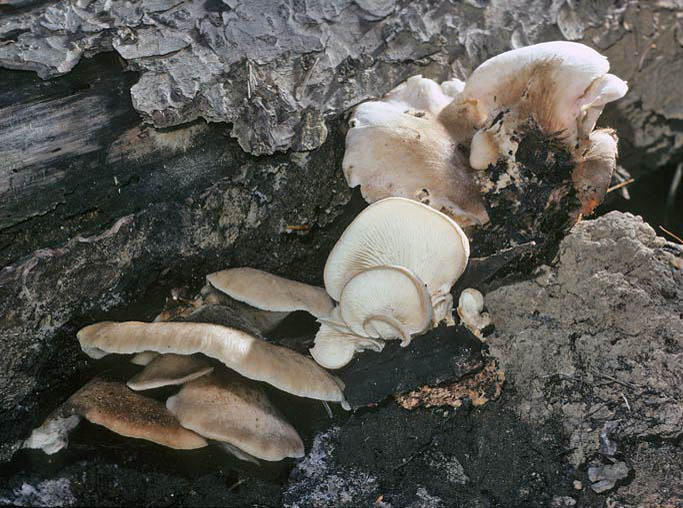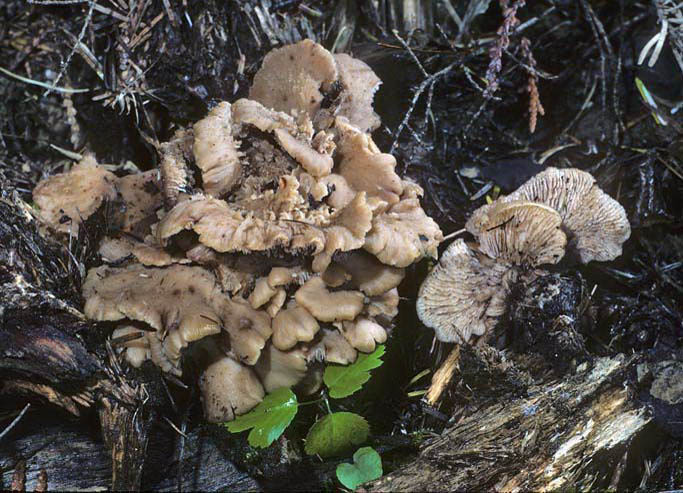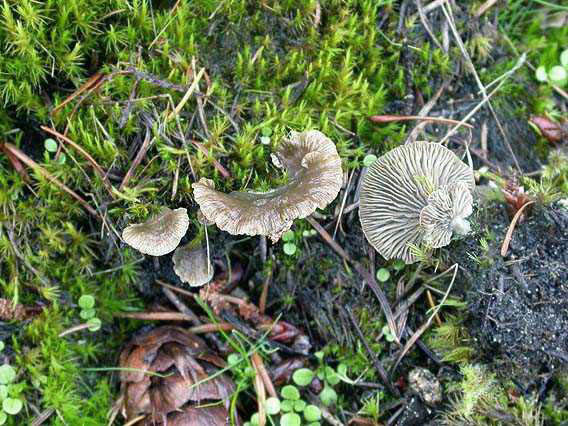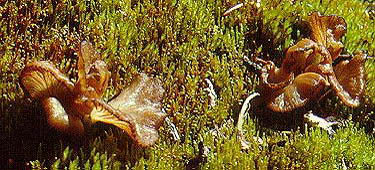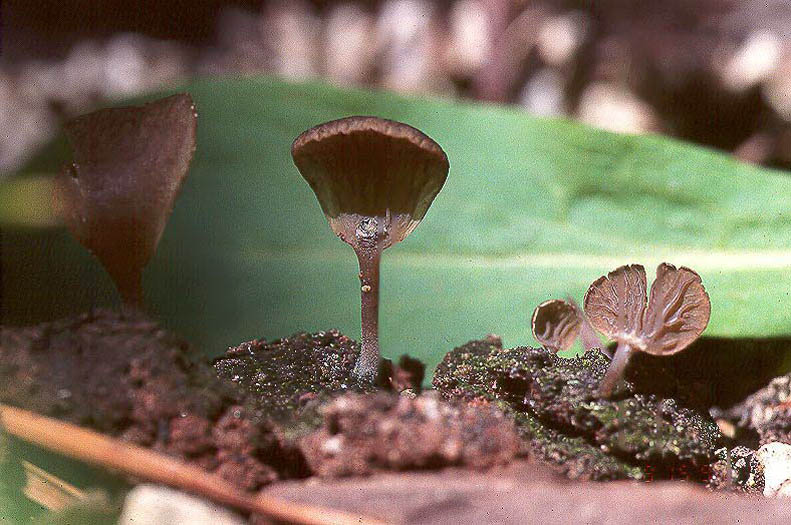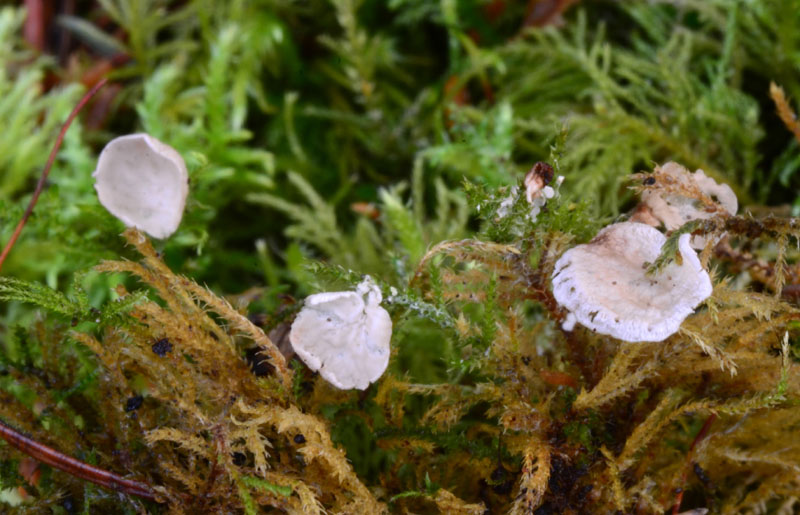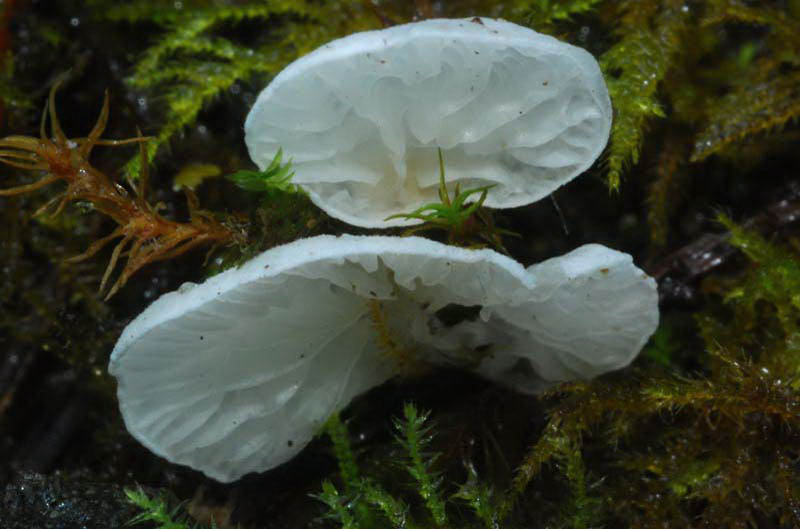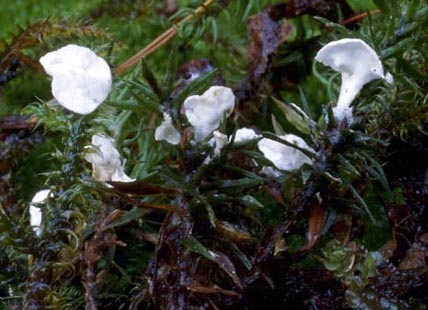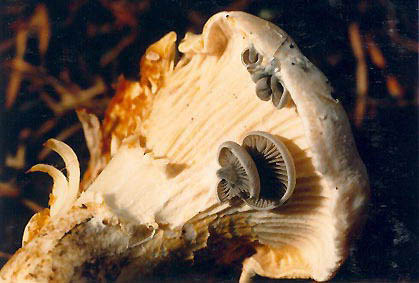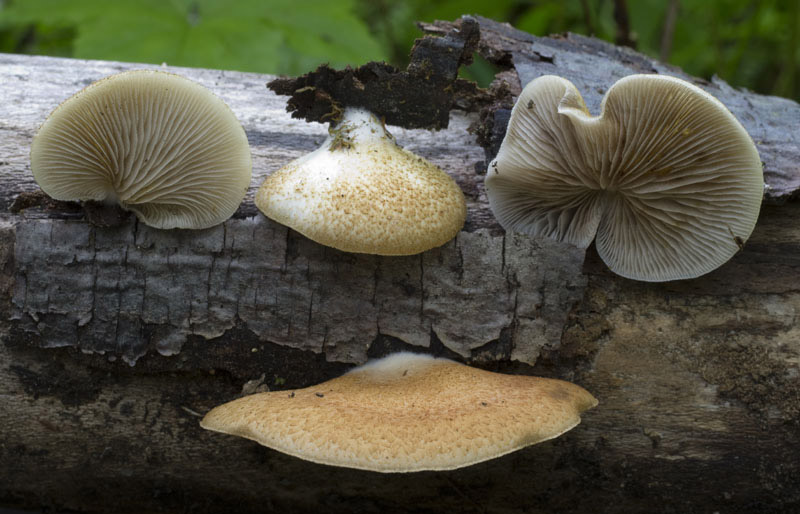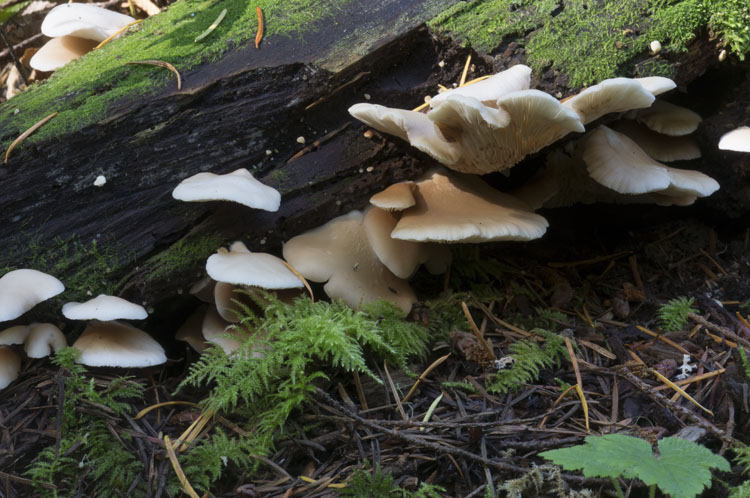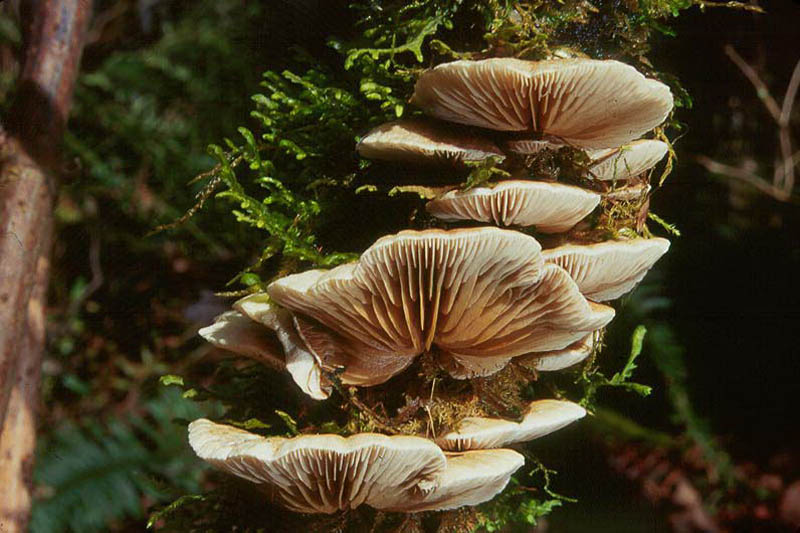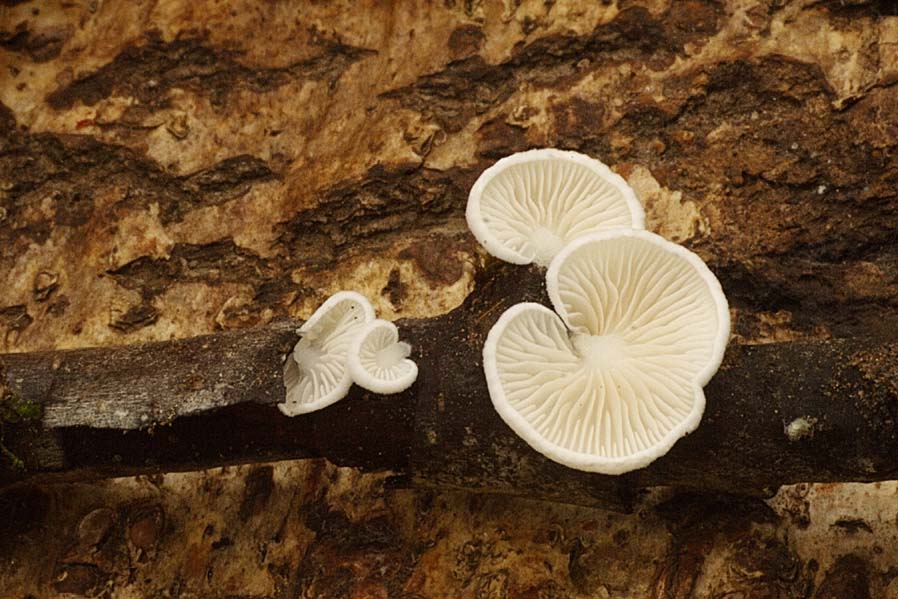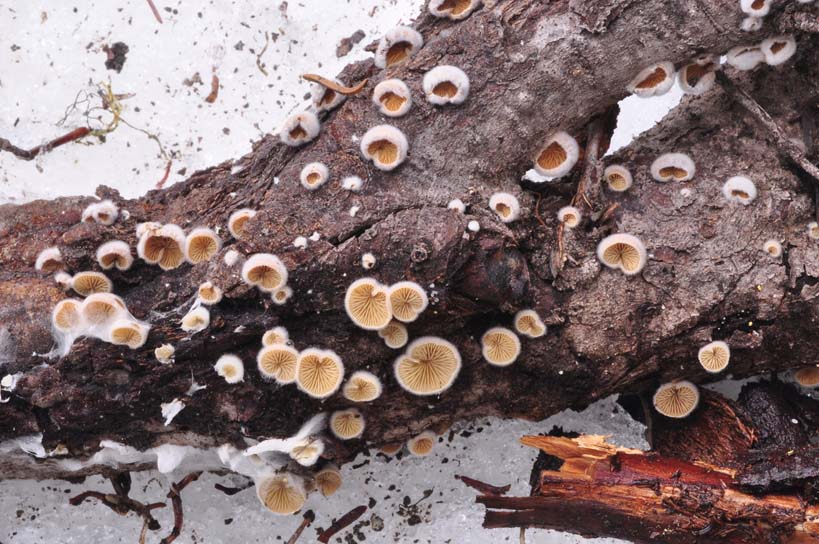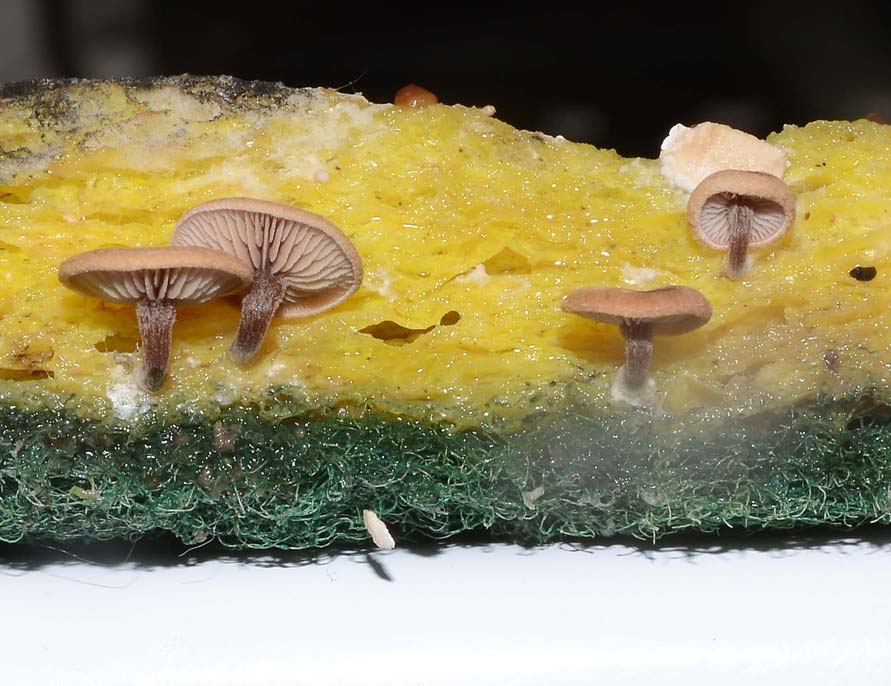Oddball Mushrooms
The most obvious odd type of mushroom is the oyster mushroom type. They grow on wood and
either have no stem or a stem that does not grow under the centre of the cap but
instead eccentrically off to one side or out of one side of the cap.
Other mushrooms have subtle signs that sometimes indicate a gilled mushroom
is not actually related to other gilled mushrooms, which I consider odd.
White Spores
- start below for oyster mushrooms, which grow on wood
with either
no stem or a stem that is stubby and
eccentric (sticking out to one side).
They are not usually tough, and don't have serrated gill edges.
Sometimes the larger ones (>5cm) will have a normal stem, so also try here
for any large ones with strongly decurrent gills.
- start here for
wood-inhabiting mushrooms with either serrated gill edges or tough fruitbodies.
If you can't detect that (it's sometimes subtle) try here for any mushroom
>2.5cm found on wood with a normal stem and decurrent
gills (but also try the regular wood inhabiting
page).
- start here for mushrooms
with possibly poorly
developed gills that grow on moss.
Pleurotus - the classic oyster mushroom from which all
mushrooms on wood with eccentric stems are now labeled as having
"oyster" stature. Recognized by the fairly large fruitbodies (up to
10cm or more) mostly on
hardwood, short eccentric stem and smooth gill edges.
P. populinus/pulmonarius/ostreatus - greyish-brown
to whitish
capped, else white. Found on hardwoods.
P. dryinus - much tougher, scaly capped and
mostly white. Rarely yellow. Has a partial
veil visible when young. Hardwoods.
Panus conchatus - large, brown cap, young
gills purple (fading), young cap and stem felty,
like Tapinella atrotomentosa.
Hardwood. Actually in the polypore clade
below.
| For a smooth-capped large bright yellow "oyster" that grows
on the ground, see
Cantharocybe. |
Hohenbuehelia species can often be recognized by a layer of gelatinous
flesh in the caps.
Hohenbuehelia 'tremula'/thornii ('petaloides') - related darker brown,
smaller (5cm) shoehorn shaped mushrooms, on the ground
from buried wood.
H. mastructata - stemless,
strongly felty, on
hardwood. Southern.
Other smaller unrelated white spored oyster mushrooms
with either no stem or an
eccentric stem, some easily confused with the smaller Hohenbuehelia
species. The exact taxonomic placement of some of these
mushrooms is uncertain, but most fall in
one of two places - distantly related to the waxy
caps (Hygrophoroid clade) or distantly related to Marasmius
(Marasmioid clade). They
come in various colours, but they all have white spores, something that is not
going to be immediately obvious. Usually small (<5cm) but some medium sized
species can reach 10cm, and the smaller ones are <2.5cm. Panellus, Sarcomyxa
and Pleurotopsis have amyloid spores (darkening in iodine).
Pleurocybella porrigens - angel wings, medium,
shoehorn shape, without any stem.
Sarcomyxa serotina - medium, late oyster. A
beautiful greenish, sometimes tinged violet, with an orange punctate stem. Early
winter. Hardwood preference.
Panellus stipticus - tough and fuzzy
and slowly bitter, short stem. Veins connect the gills which
sometimes glow weakly in the dark. Hardwoods.
Phyllotopsis nidulans is stemless and stinky.
Scytinotus longinquus - viscid, white to tan to pink. Short
stem. <4cm. Hardwood. Hygrophanous.
Cheimonophyllum candidissimum - <2 cm, short or absent stem on
hardwood. Dry, white chalky cap, not peelable.
'Panellus' mitis - Smaller than P. longinqua, white,
not viscid, peelable cap cuticle and gill edge. Short stem. <2.5cm
Scytinotus ringens - Also <2.5cm, rose-grey cap, not viscid,
not peelable. Shortest stem. Hardwood. Hygrophanous?
Tectella patellaris - a smaller brown oyster with a
veil! A tiny stem may
come out of the cap!
~1cm. Hardwood.
Phyllotopsis nidulans - orange, fuzzy, stinky and
stemless. Medium. Panellus stipticus is stemmed,
bitter and not stinky.
Resupinatus sp. -
teensy (~3 mm) circular grey to black stemless fuzzy capped
caps
on wood. A bit gelatinous. Similar Hohenbuehelia species are
rumoured and have metuloid cystidia.
Campanella (Tetrapyrgos) subdendrophora - spots dark
bluish-grey, cross-veined
pseudo-gills, lateral stubby stem on Rubus canes. <1 cm.
Campanella "veiny" - similar, larger (>1 cm), even more
cross-veined, stemless.
| The latest taxonomy suggests that 1, 2 and 9 are related to the true
oysters in the Pleurotineae sub-order. 3, 4, 5, 7, 10, 11 and 12 are in the large
Marasmiineae sub-order. 6 and 8 are unknown (or distinct) for now. |
Polypores - most of these "oysters" are more closely related to the
polypores (although in different sections of that
family tree) and
have independently evolved gills, but they still retain some of the toughness of the
polypores due to their dimitic hyphae. (Pleurotus dryinus can be mistaken for one of these). The
stems are often missing or slightly eccentric as well, but this can be
subtle.
|
If your stemless gilled mushroom is actually as tough as wood, you will probably find in on the polypore page.
|
This first group is easiest to recognize because they lack
a stem, are attached to wood, and look and feel for all the world like a polypore, except for the gills
underneath. They have the consistency of leather (Schizophyllum) or wood. Other species have odd
looking pores that can somewhat resemble gills as well, so if you find something
that looks like it has gills but seems like a polypore,
look for it on that page.
Schizophyllum commune - "split gill", in the
Agaricales (a gilled mushroom relative that evolved to be tough instead of
a tough polypore evolving gills). Each
gill is split in half lengthwise. White fuzzy cap
on hardwoods. <5cm.
Trametes (Lenzites) betulina - on birch, pale,
concentric, thinner too. Susceptible to algae. <10cm.
Representing a tough polypore that evolved gills, the opposite of
Schizophyllum.
Gloeophyllum sepiarium - red or orange brown
hairy cap. Distant gills. <10cm. In the Gloeophyllales with Neolentinus.
G. trabeum - smooth cap, crowded gills.
| Trichaptum laricinum -
purple gills underside when young, resembles T.
biforme. On conifers. |
These look very much like regular gilled mushrooms growing on
wood. Panus has smooth gill edges (the hardest one to
identify as "odd"), Neolentinus
has serrated gills. Some of them are tough. The gills are usually
decurrent. They are
all rarely encountered, with N. lepideus, N. ponderosus and P. conchatus
possibly being the least uncommon. The sizes range from small (5cm)
medium (10cm) to large (15cm), while Neolentinus ponderosus may be 50cm across!
Panus conchatus - large, brown cap, young
gills purple (fading), young cap and stem felty, like
one
Tapinella.
Hardwood.
Lentinus neostrigosus (strigosus) ('Panus rudis') - large, hairy capped,
also purple when fresh.
Hardwood.
Neolentinus lepideus - serrated gills, medium,
partial veil, scaly cap.
In the Gloeophyllales.
Neolentinus ponderosus - serrated gills,
possibly
huge, scaly cap. One of our largest mushrooms! No veil.
Neolentinus kauffmanii - serrated gills,
small. Pinkish-tan. Easily mistaken for Lentinellus
or Clitocybe, as is N. adhaerens.
Peppery.
Neolentinus
adhaerens - serrated gills, small, covered in
red-brown resin. Bitter.
| Other tough gilled mushrooms to consider that are not
related to the polypores are
Leucopaxillus. |
Lentinellus - also with serrated
(usually decurrent) gills, but
these mushrooms are soft and related to Russula
and Lactarius, which makes them not actually
gilled mushrooms in the strict sense. The stems are either absent, eccentric
or fused together. The stems are never thicker than 5mm (unlike
Neolentinus.. They are generally smaller (<5cm)
but some are larger. All are
uncommon. Their spores also have amyloid warts (darkening in iodine).
L. 'flabelliformis'/occidentalis/subargillaceus - small species (<3cm) with no stem or a short, lateral, stubby stem.
L. micheneri - with a stem, bitter.
Small. Cap usually hygrophanous and more depressed than Neolentinus
kauffmanii.
L. montanus - a large fuzzy capped stemless species growing at high
elevations in the spring near snow on conifers.
L. ursinus/castoreus - similar large stemless fall species on hardwoods.
L. 'vulpinus' - large (~10cm across) species possibly with
short stems clustered together? Hardwoods.
L. 'cochleatus' - smaller (<5cm) clustered species on hardwoods with cleft caps.
Moss dwellers: tiny (1cm or so) stem-less mushrooms found on the ground on moss,
sometimes with poorly formed gills that might be mistaken for a
tiny cup Ascomycota fungus. Most are in the
same family as the
waxy caps (Hygrophoraceae), except for one
oddball more closely
related to some polypores! (Hymenochaetales). All are uncommon. Other
Arrhenias are found on the Omphalinoid
page, as that genus has 2 distinct looks.
Arrhenia 'subglobisemen' ('acerosa') -
brownish grey, real gills, eccentric stem
A. 'lobata' - only
wrinkled/veined, no
stem, translucent in
very wet places.
A. 'auriscalpium' - wrinkled/veined, long lateral stem.
Arrhenia 'retiruga' - white to pale grey,
almost smooth underneath,
stemless. Finely felty cap.
Rimbachia bryophila - very similar but
purer white with better developed
rudimentary gills.
Rimbachia arachnoidea/neckerae - completely smooth underneath
(also white, stemless and felty capped).
Muscinupta 'laevis' ('Cyphellostereum' 'laeve') - bright white, almost a
stem,
unlike A. retiruga. Hymenochaetales.
Pink Spores - Also found on the
Entoloma page, these species are repeated here
for convenience. Not hygrophanous.
Claudopus - pink spored mushrooms found
on wood or other mushrooms,
sometimes with tiny eccentric or
absent stems.
Claudopus byssisedus (avellaneus) - fibrillose, brown.
Farinaceous. 2.5cm or
so. Tufts of rhizomorphs at the base.
Clitopilus hobsonii is a similar rare "oyster",
whiter.
Claudopus parasiticus - parasitic on chanterelles!
Fibrillose, grey. <1cm. Tiny stem.
Brown Spores - Most mushrooms in this section have regular brown spores. Some
species of Melanotus have dark purple-brown spores. Mostly not
hygrophanous.
Most brown spored oysters belong to Crepidotus, a common
stemless group in the same family as many of the LBMs
and closely related to Simocybe. Typically <5cm across,
but some are even smaller (<2.5cm). Most often found on hardwoods.
C. calolepis group ('mollis') - Gelatinous
cuticle, hairy
cap that can be peeled off.
C. crocophyllus - Beautiful yellow gills,
brown to golden fuzzy cap.
C. applanatus - white, aging to tan. Larger and hygrophanous,
unlike
the other nondescript white species. (<4cm). Round spores.
C. lundellii ('amygdalosporus') - also white,
aging to tan, but smaller (<2cm).
Usually on hardwood. Elliptical spores.
C. fusisporus/subverrucisporus/variabilis - similar but much rarer.
C. epibryus (herbarum) - very similar as well (<2cm), but a
lighter brown spore print than the others and sometimes more
circular.
Spindle shaped spores.
C. fimbriatus - yellow-brown cap underneath the fuzz, even
when fresh.
Also consider Tapinella.
Tapinella panuoides - very much like Crepidotus.
<10cm,
odd gills that get wavy towards the point of attachment, or fork,
or have interconnected veins. On conifer
logs with no stem.
Possibly fibrillose. A gilled
bolete.
Finally, an odd brown spored mushroom - Melanotus,
pale to dark brown, with a small eccentric stem, found on wood or
sometimes on carpets and fabric! It may have regular brown or dark
purple-brown spores. It is related to (and probably actually
is) Deconica (Psilocybe) in the Strophariaceae
family, although it does not really resemble it from a human point of view. When I
find it, the stem, although small, often looks normal and not eccentric so you might look for it
elsewhere.
Dryer cap than Pholiota. Something close to
adnate gills, but attachment varies. Tiny mushrooms are hard to get a spore print from, so you may even
look for it on the white spored marasmioid page. Very small (<2.5cm)
Deconica (Melanotus) horizontalis (textilis) - pale to dark brown, sometimes
furry cap and stem. Purple-brown spores. <2cm.
M. phillipsii/caricicola - paler, pale brown spores,
not furry, on grasses and plants. <1cm.
Specimens I found today on an old kitchen scrubbie I left
in the wash basin.
Very similar to Simocybe,
which usually has a longer stem and a fuzzier base.
Since the mushrooms I have decided to group together on this
page are not all related to each other, but represent at least a half a dozen
separate lineages of the mushroom family tree, there is no good specialized
literature for this group.
